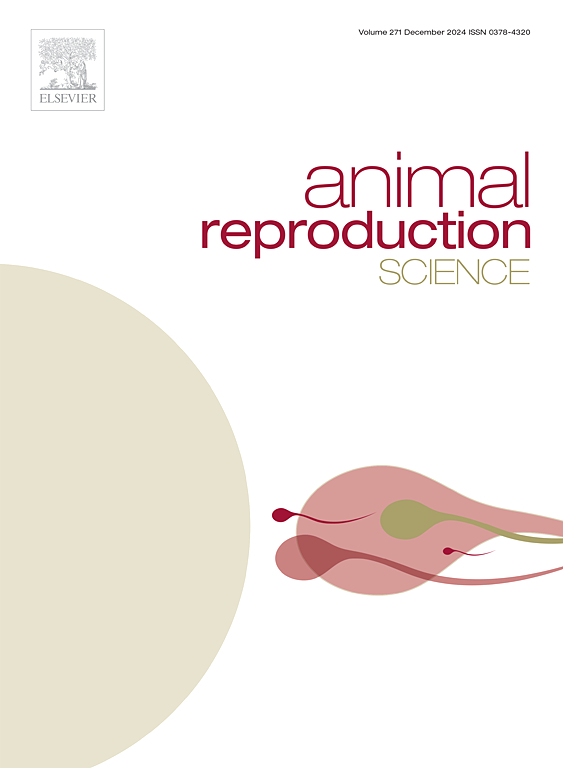通过抑制雄性家猪新生儿 LH 的升高来抑制睾丸的发育。
IF 3.3
2区 农林科学
Q1 AGRICULTURE, DAIRY & ANIMAL SCIENCE
引用次数: 0
摘要
新生儿期循环中黄体生成素(LH)的增加对睾丸的发育至关重要。在雄性猪体内,血液中的 LH 水平在出生后 1 周左右开始上升,并在 5-6 周龄时恢复到基础水平。本研究测试了一种假设,即新生仔猪接受雌激素和雄激素的联合治疗会抑制 LH 的分泌,从而抑制睾丸的发育。仔猪出生后第 1 天开始接受含有雌二醇(E2,8-40 毫克)和醋酸群勃龙(TBA,40-200 毫克)的缓释植入物或保持原样。在 4 周龄时,未接受治疗的雄性猪的平均血清 LH 浓度为 7 纳克/毫升,而接受植入治疗的猪的血清 LH 浓度小于 1 纳克/毫升。尽管LH浓度有所降低,但在植入植入物的猪的垂体中仍能检测到LH。有趣的是,新生儿阉割也会降低循环 LH,这凸显了睾丸生理在生殖轴早期建立中的重要性。较高剂量(20 毫克 E2 + 100 毫克 TBA)能更有效地抑制睾丸功能,与完整猪相比,循环睾酮浓度较低就证明了这一点。此外,E2 + TBA 处理对睾丸生长有持久影响,导致 26 周龄时睾丸变小,并出现未成熟的莱伊杜氏细胞。总之,新生儿 E2 + TBA 治疗抑制了出生后 LH 的上升和睾丸的生长,直至上市年龄,为雄性猪提供了一种潜在的非手术阉割替代方法。本文章由计算机程序翻译,如有差异,请以英文原文为准。
Inhibition of testicular development by suppressing neonatal LH rise in male domestic pigs
The neonatal increase in circulating luteinizing hormone (LH) is crucial for testicular development. In male pigs, blood LH levels start to increase approximately 1 week after birth and return to basal level by 5–6 weeks of age. This study tested the hypothesis that neonatal treatment with a combination of estrogens and androgens suppresses LH secretion and thereby inhibits testicular development. On Day 1 after birth, piglets received a slow-release implant containing estradiol (E2, 8–40 mg) and trenbolone acetate (TBA, 40–200 mg) or remained intact. At 4 weeks of age, mean serum LH concentrations were ∼ 7 ng/mL in untreated males, whereas pigs with implants had serum LH concentrations < 1 ng/mL. Despite this reduction, LH was still detected in the pituitary glands of treated pigs. Interestingly, neonatal castration also lowered circulating LH, highlighting the importance of testis physiology in the early establishment of the reproductive axis. The higher dose (20 mg E2 + 100 mg TBA) inhibited testis function more effectively, as evidenced by lower circulating testosterone concentrations compared to intact pigs. Furthermore, E2 + TBA treatment had a lasting impact on testicular growth, resulting in smaller testes at 26 weeks of age and the presence of immature Leydig cells. Overall, neonatal E2 + TBA treatment suppressed the postnatal LH rise and testicular growth until market age, offering a potential non-surgical alternative to castration in male pigs.
求助全文
通过发布文献求助,成功后即可免费获取论文全文。
去求助
来源期刊

Animal Reproduction Science
农林科学-奶制品与动物科学
CiteScore
4.50
自引率
9.10%
发文量
136
审稿时长
54 days
期刊介绍:
Animal Reproduction Science publishes results from studies relating to reproduction and fertility in animals. This includes both fundamental research and applied studies, including management practices that increase our understanding of the biology and manipulation of reproduction. Manuscripts should go into depth in the mechanisms involved in the research reported, rather than a give a mere description of findings. The focus is on animals that are useful to humans including food- and fibre-producing; companion/recreational; captive; and endangered species including zoo animals, but excluding laboratory animals unless the results of the study provide new information that impacts the basic understanding of the biology or manipulation of reproduction.
The journal''s scope includes the study of reproductive physiology and endocrinology, reproductive cycles, natural and artificial control of reproduction, preservation and use of gametes and embryos, pregnancy and parturition, infertility and sterility, diagnostic and therapeutic techniques.
The Editorial Board of Animal Reproduction Science has decided not to publish papers in which there is an exclusive examination of the in vitro development of oocytes and embryos; however, there will be consideration of papers that include in vitro studies where the source of the oocytes and/or development of the embryos beyond the blastocyst stage is part of the experimental design.
 求助内容:
求助内容: 应助结果提醒方式:
应助结果提醒方式:


